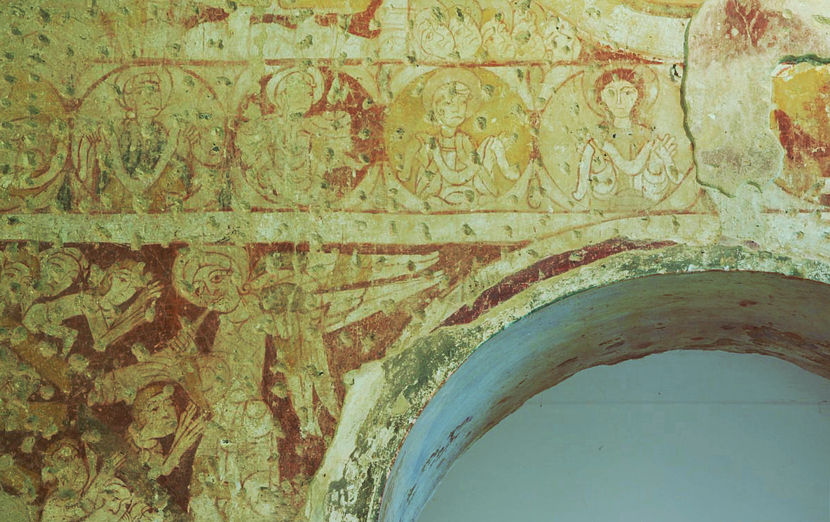Houghton-on-the-Hill, (nr. South Pickenham) Norfolk C.11?
Trinity (Detail, Apostles) & Last Judgement
Uncovering and restoration is going on currently at Houghton-on-the-Hill, where the paintings are perhaps the most remarkable found in modern times in England. Here is what was visible on the chancel arch wall when the photograph was taken in April 2000. At the upper right of the picture is most of the lower left quadrant of a large roundel. What it contains is still not clear in detail on the wall, but it has been identified as a Trinity of a type most familiar in Western art from the famous example by Masaccio in Santa Maria Novella, Florence – God the Father stands behind, supporting the Cross on which the Son is crucified, with the Holy Spirit in the form of a dove also present. But not only is this painting much earlier than Masaccio’s early 15th century example, it seems on present indications (more of the roundel still remains to be uncovered) to be combined with the Doom, or Last Judgement. If this turns out to be true, then this treatment of the subject may be unique.

There are three tiers visible here – the topmost with the roundel and something as yet unidentified on the left. Below this, and much clearer, is a row of head-and-shoulders figures with scrolls, each of them also in a roundel; another three are faint but detectable to the right beyond the apex of the chancel arch opening, and there were probably twelve originally. These figures are thought to be the Twelve Apostles, shown here as co-assessors at the Judgement. The belief that they would actually take part derives from Luke 22:30 where Christ at the Last Supper promises the disciples that they will ‘sit on thrones judging the twelve tribes of Israel’. The figures, all painted as young and beardless, hold scrolls, perhaps bearing the appropriate sentence from the Apostles’ Creed¹.
In the lowest tier, and thus to the left of the chancel arch seen here on the right, is the human experience of the Doom or Last Judgement. Moving left from the opening into the chancel, a haloed figure, presumably an angel, with large almond eyes and long, elegantly streamlined wings extended behind him to the right, is blowing a trumpet. To the left of this, souls, including one who may be female to the immediate left of the trumpeting angel, hold out their hands in supplication.
This painting is certainly very early, but its exact date is still debatable. A date in the 11th century has been claimed, and that may well turn out to be correct. But some of the painting at Houghton – once again not all of it fully uncovered – is later, including, on the South Wall, a Harrowing of Hell.
More will be known when the uncovering and conservation work at Houghton is complete, but the survival of the paintings is remarkable – the more so because it was largely a matter of luck. The fact that they are still there to be found is due almost entirely to a local engineer and surveyor, Bob Davey, who single-handedly rescued this church from dereliction after many years of disuse and neglect. Other paintings of the Doom are listed below.
Website for St Mary’s, Houghton on the Hill
¹ Discussed briefly in connection with the painting of St James the Great at Hales, Norfolk